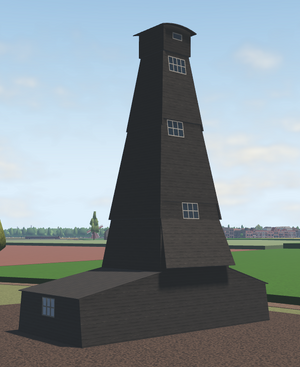| Salt towers | |
|---|---|
| Real life location | In the triangle Enschede - Hengelo - Boekelo |
| Game location | Scattered across the south-east corner of the map |
| Construction years | 1918-1933 |
| Function | Salt mining |
The salt towers are a collection of landmarks based on salt drilling towers.
Lore
In 1890 the then small town of Helmelo attempted to find drinking water underground by drilling for it. Much to their dismay, the drills only uncovered large quantities of rock salt. A second attempt was done later that year, though this had the same result: rock salt. Helmelo gave up drilling for water and continued to purify water from nearby ditches. There was no interest in the salt either; imported salt was much easier to use and already purified.
When the Staatsspoorwegen (SS) decided to extend their mainline in 1895, Helmelo's major requested that they would also get a station. It would make the import of good much easier and, if the large salt mine Helmelo was sitting on was ever needed, could make exporting it much cheaper too. Despite this, the need for Helmelo's salt would only come much, much later.
Due to the First World War, importing salt was no longer an option. A company was raised to mine salt from Dutch soil in 1918. This company, the KNZ, was such a success that it soon built a second factory, though began running out of ground to extract salt from. In the early 1920s, it discovered that Helmelo was sitting atop a large salt deposit. In 1927, the KNZ bought a large factory building from A. Visser, who's quickly expanding business had outgrown it.
The building was adjusted to fit its new purpose and two salt towers were erected in Helmelo. The town had grown considerably so the company hired people to find more places to drill for salt. New salt towers were built. The seventh and last tower was built in 1938 in Hazeldrecht, farther out than any other.
Many of the machinery in the towers was stolen or confiscated during the Second World War, much to the dismay of the KNZ. After the war, technology had progressed so much that a lot of the towers were now unneeded as extracting salt could be done as, if not more, efficient with fewer towers or even from within their factory complex. Most towers were sold off to the locals and are now in use as a shed, wine cooler or tree-less treehouse. The remaining towers, closest to the factory building, remain in factory use.
One of those towers has not been overhauled and still drills salt like the others used to in the 1920s. This is because the director of the factory building has a soft spot for older technology. On rare occasions, paid tours are hosted in the tower as it is drilling.
Real life
In 1887, in the gardens of Twickel castle, test drills for drinking water were performed. Instead of water, large amounts of salt were found. After more attemps, it was discovered large rock salt layers, some of which 225 million years old(!), spanned a large area in the east of the country. It is likely some salt towers were built, though not many. People preferred the salt that was imported from Germany.
This attitude changed during the First World War, as German import came to a halt and created shortages. The Koninklijke Nederlandsche Zoutindustrie (Royal Dutch Salt Industry) began mining the salt in 1918.
The factory of the KNZ attracted a lot of people, both workers and guests, which assisted greatly in the development of the region as hotels, another factory and more salt towers were built. From 1937 onwards the towers also appeared around railway tracks, peaking at 75 in numbers.
After the Second World War, most of the salt towers were replaced with salt houses. These much smaller constructions had more modern technology and used hot water to pump the salt up, rather than drill for it.
Trivia
- Currently there are 7 of these towers in-game.


